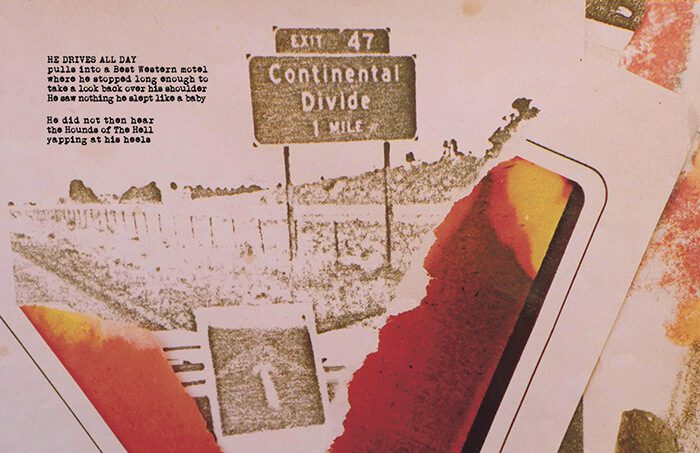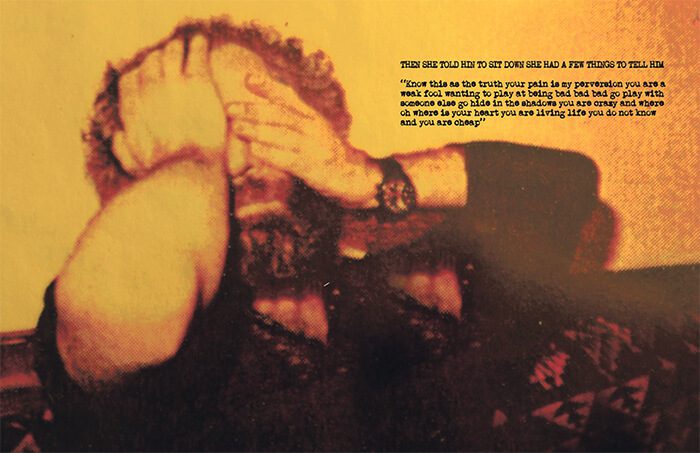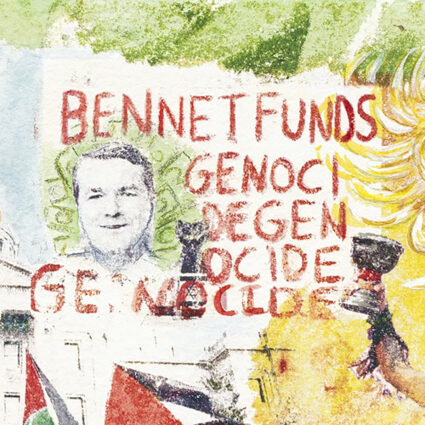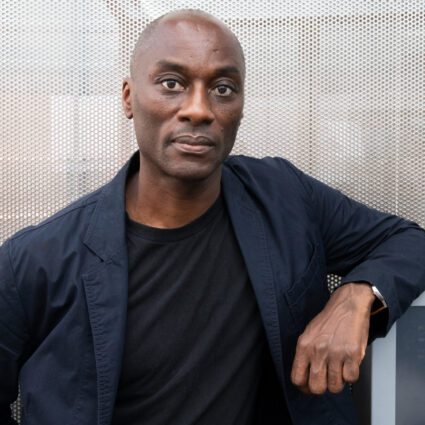
When Lauren Tresp bought THE Magazine in early 2016 from its founding publisher, the former New York fashion photographer Guy Cross, he was happy to retire. But he’s hardly been idle since he put that final issue to bed last winter. Looking casual yet dapper in chinos, a black tee, and running shoes, today Cross is the picture of relaxation.
It hasn’t always been like that: the photo book that has occupied him for this past year tells a frenzied, noir tale of cocaine, women, and dark urges for “more, always more.” Holy Misery: Chapter One is the digitized and reworked version of Cross’s experiences in the late 1980s, a tale he first constructed around 1988 as an assignment to create a narrative for a class taught by photography professor (emeritus) Thomas F. Barrow at the University of New Mexico. The images and text are Cross’s, and, quite frankly, cause the reader to wonder just how anyone survived the ’80s. As Cross tells it, “Those were dark years, very dark years, of cops and crooks, women, cocaine, the endless war of desire when more isn’t enough. It’s a story about sad, disconnected, lost souls in the ’80s,” which compare unfavorably to the idealistic ’60s and ’70s, in Cross’s opinion. The tale hits hard and leaves little doubt that the narrative is based on his personal experience of the Wolf-of-Wall-Street decade in Santa Fe and Los Angeles—from the Palace saloon to the Chateau Marmont.
Cross recalls that, after selling the business that he started in 1992 with his wife Judith, he removed himself from attending openings and kept to activities such as gardening and walking. “I wanted to disappear for a while. There was a conundrum of what to do once the magazine had sold.” Holy Misery represents a revisiting of “something I did thirty years ago, updating it in digital form. Chapter one is done. I have no goal or expectations in mind for it.” With no deadline, he took a year to rewrite; the result is “a mix of the original story, written mostly in LA in a small guest house while listening to Bob Dylan at full volume.” He wanted to challenge himself and do something that “makes [him] feel good about it.” He relished “getting back into the rhythm of it.” That rhythm is somewhat reminiscent of Jack Kerouac’s On the Road mania. Find Holy Misery and other projects by Cross on the forthcoming website, guycross.com. Guest bloggers will be welcomed, he says, adding, “If you want to put your foot in your mouth, go ahead.”
It’s a story without a beginning or end. I’m doing it like the Surrealists did automatic writing; I have to find the place where it loops in on itself.
Cross’s newest project is titled Figure It Out, begun about a month ago, after a brief spell of the “now whats?” that came from putting Holy Misery back together again. Figure It Out is about spatial relations and uses found words and pictures from “surfing down the rabbit hole of the web, pulling out phrases and images, out of context, that mean something to me. It’s a story without a beginning or end. I’m doing it like the Surrealists did automatic writing; I have to find the place where it loops in on itself.” He’ll be posting a few pages at a time on his new website.

Ever interested in the business of publishing, especially in Santa Fe, Cross doesn’t read THE now from cover to cover; he put it down for the past year but still looks at it and counts the number of ad pages. He feels that Tresp is doing a good job at “making it her own, which is the most important thing. It’s a one-man show; the buck stops with you. She’s very centered, focused, and can build this into something really big for herself. The magazine looks good, with a whole different dynamism.”
Falling into a conversation about other local publications, he, as always, has his opinions and isn’t afraid to voice them. Of Local Flavor, “how sad: no idea of design, a jumble. Not an easy read. Stop trying to be everything to everybody,” of Pasatiempo, “better than it used to be, but it’s still just a weekly,” and of the Santa Fean, “the worst waste of paper I’ve ever seen. . . With the name Santa Fean, the publisher had the chance to do a real city magazine but didn’t.”
His conclusion? “THE shines compared to the others.” And with that, Cross affirms that he’s “never going back into the business. I’m 77, 78 in December. In the last two years, not only did I sell the magazine, but I had a kidney removed and several other surgeries and procedures. It’s all changed me. I am being taken care of. Judith and I watch out for each other. I learned a little bit of kindness. It’s about time, right? It’s not important what you want; it’s what you need. If you live within your needs, not your wants, it’s a simpler life.”
He muses about Santa Fe when he arrived in 1978: “The art scene was Munson and Hills galleries and a few others. By the early 1980s, the whole thing was changing: cocaine came into town; restaurants were opening; Santa Fe became a ‘contemporary art town.’ SITE Santa Fe showed up and sealed the deal. But that life can only last twenty, twenty-five years. It’s a generational thing. Lauren now has to build a new base of advertisers. Collectors aren’t coming to buy blue-chip artists anymore. It’s a new town with new goals.”
Cross is just fine with it all, offering, “I’m lucky; I’ve got a nice place in the country, birds to listen to, trees to meditate under, flowers to grow. I’m happy.”
Guy Cross was born in 1939 in New York City. He worked as a fashion and beauty photographer from 1967 to 1978 in New York and London doing commercial and editorial photography for Condé Nast Publications, Fairchild Publications, Redbook, Seventeen Magazine, English Vogue, Texas Monthly Magazine, Coty, Evergreen Review, and Faberge, among others. He was the co-publisher and co-creative director of The Picture Paper in Santa Fe from 1978 to 1981. He was publisher and creative director of Edge City Magazine in Eureka, CA, from 1988 to 1992, and was publisher and creative director of THE Magazine—Santa Fe’s magazine of the arts from 1992 to 2016. His fine art photographs have been exhibited in Santa Fe at LewAllen Contemporary and Klaudia Marr Gallery. He had a solo show at the 18th Street Arts Complex in Santa Monica and a solo installation at the Museum of Rock Art in Los Angeles, among others. He had several photographs in the 1998 invitational show The City Series: Santa Fe, Taos, Albuquerque at the Cedar Rapids Museum of Art. He has also photographed album covers for Muddy Waters, Rita Coolidge, Happy Traum, and Eric Anderson.



